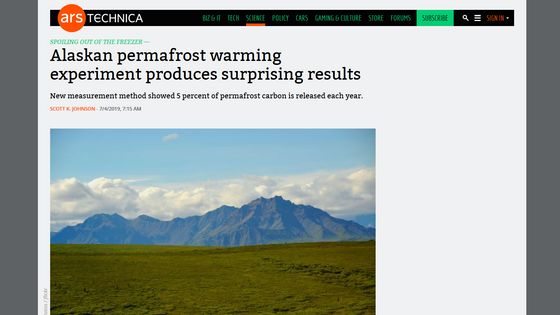It turned out that the amount of carbon released by melting permafrost was more than expected, affecting the global warming countermeasures

by
Global warming is caused by greenhouse gases such as carbon dioxide, but other factors that increase carbon dioxide levels include the use of fossil fuels and deforestation, as well as the permafrost melting. There are also things. It seems that the carbon trapped inside by melting permafrost will be released into the atmosphere as a greenhouse gas such as carbon dioxide and methane gas, and a research team at the University of Northern Arizona investigates the amount of carbon released by melting permafrost Announced the results.
Direct observation of permafrost degradation and rapid soil carbon loss in tundra | Nature Geoscience
https://www.nature.com/articles/s41561-019-0387-6
NAU scientists find carbon from thawing permafrost is released into the atmosphere at higher rates than previously thought
http://news.nau.edu/schuur-carbon-permafrost-study/
Alaskan permafrost warming experiment produces surprising results | Ars Technica
https://arstechnica.com/science/2019/07/permafrost-experiment-shows-surprising-amount-of-co%e2%82%82-release/

Permafrost refers to soil that has been frozen continuously for longer than two winters and the intervening summer, and accounts for 20% of the continent in the Northern Hemisphere. It is not surprising that permafrost begins to melt due to global warming, but it is known that permafrost contains a lot of carbon, so
Human emissions can be reduced intentionally, such as by switching from fossil fuel-based power generation systems to clean energy. However, whether or not permafrost begins to melt depends solely on changes in temperature, so humans can only affect it indirectly.
As the global warming progresses, a lot of permafrost begins to melt, and the carbon dioxide and methane gas released from the melted permafrost further accelerates the global warming cycle. It is one of the feedbacks to proceed Understanding the amount of carbon dioxide released when such permafrost begins to melt is important for countermeasures against global warming.

by
A research team at Northern Arizona University conducted a study to measure how much carbon is released by melting permafrost. At first glance, the measurement of carbon emissions from permafrost seems easy, but the quantitative measurement of carbon emissions from permafrost is difficult because the density of the soil changes depending on the subsidence and depth due to thawing. It was so.
The research team decided to measure the ash remaining in the soil to solve this problem. The team was released by measuring the amount of ash and carbon remaining after permafrost had melted out by quantifying the amount of carbon corresponding to the ash content, a relatively stable component in the soil. It is said that the amount of carbon could be measured.
A five-year survey of Alaska's permafrost, which has begun to thaw due to climate change, has shown that more than 5% of the carbon in the thawed permafrost is released into the atmosphere annually. Previous projections estimated that 5 to 15% of the carbon contained in all permafrost would be released by 2100. It seems that 70% of the total carbon is released.

by Terry Feuerborn
The results of this study suggest that the “feedback to global warming”, which progresses as global warming progresses, has a greater impact than previously predicted, and suggests the danger of rapid global warming. 'Studies measuring the amount of carbon released from permafrost are an important and overlooked link to determine the magnitude of the impact of permafrost on global climate change,' the researchers said.
Related Posts:
in Science, Posted by log1h_ik







